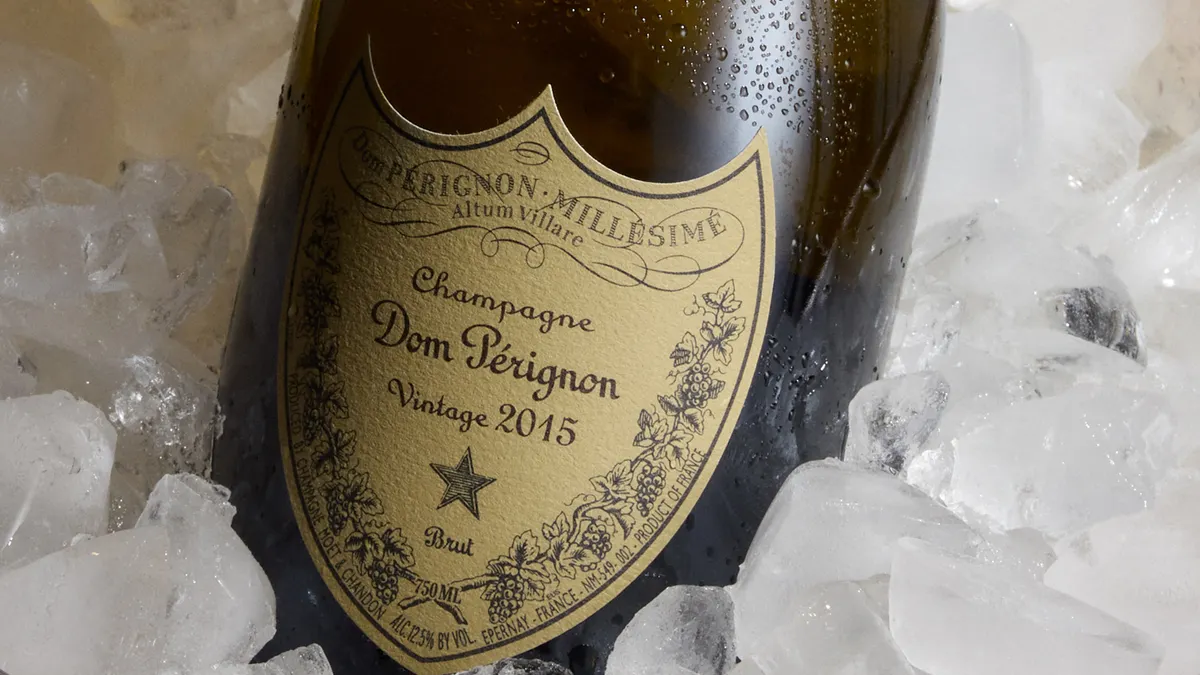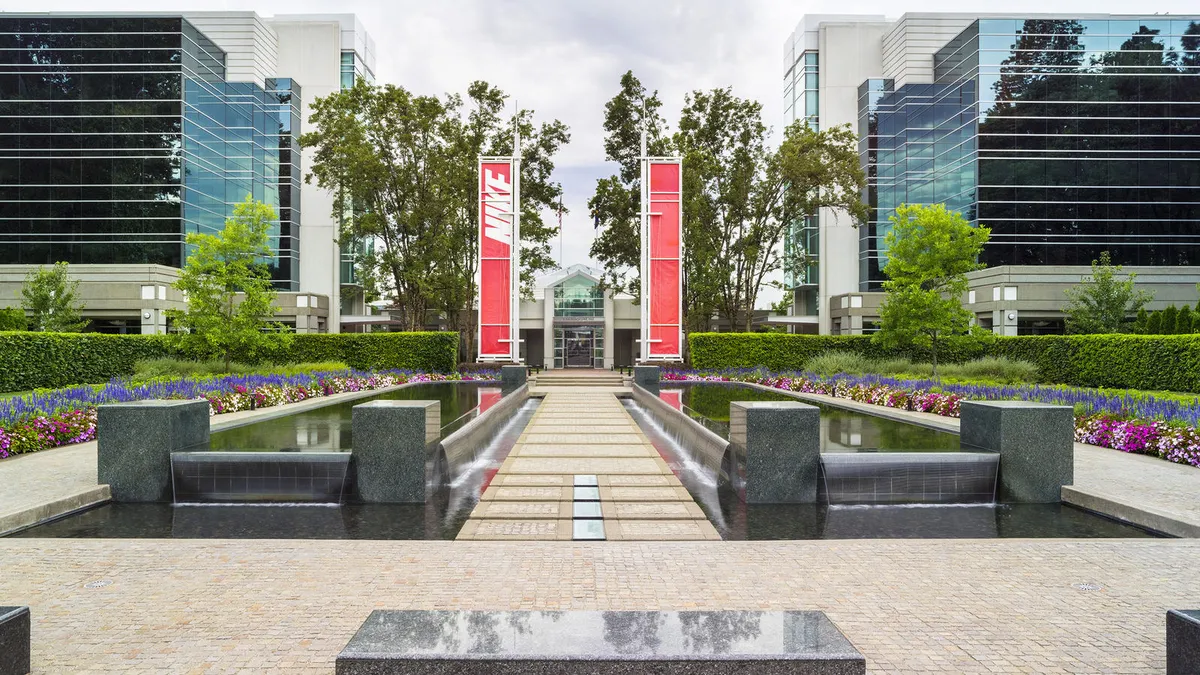For an industry dependent upon the world's pithiest affirmation — "I do" — bridal retailers are confronting a lot of "I don'ts" as their market unravels.
It's a niche market on a good day, with all the challenges that entails. Customers for the most part require high-touch service and, while they may plunk down a pretty penny — the average spent on a wedding dress in the U.S. last year was $1,750, according to an April wedding attire report from The Knot magazine — they don't intend to return to buy more.
"Bridal retail is a rather unique segment in the industry, and it's built around experience," Ray Hartjen, marketing director of RetailNext, told Retail Dive in an email. "It's also the ultimate connected shopping journey, although it still oftentimes begins with the most analog of touchpoints, and that's the largest, thickest magazines known on the planet. Those journeys then often resume at retail, where things really get different. How many other segments entertain shopping parties between 3 and 20, all expecting mimosas and the like, while only one person is converting, and with luck you get some add-on dress sales to others in the party?"
But it's not "a good day" for wedding apparel. Business at bridal stores, "has slightly declined over the five years to 2018, as the falling marriage rate has clashed with a strong macroeconomic climate," according to IBISWorld, which pegs the five-year revenue decline at an annualized rate of 0.1% to $2.4 billion, including 0.4% growth in 2018. The good economy has likely mitigated the trend, so an economic downtown could mean couples will splurge less and slow things down even more, according to the report.
The reasons for the tapering marriage rate align with other factors undermining sales, including the fact that Americans are waiting until they're older to get hitched, leaving many millennial and Gen Z shoppers out of the picture. That could get starker as high levels of student debt and other financial challenges increasingly force younger consumers to prioritize spending. More than half (59%) of those between 18 and 23 years old who plan on buying a home want to before they're 30, and more than half have already started saving, according to Bank of America's Homebuyer Insights Report. When asked by the bank what they'd do with $5,000, 80% said they would put it toward a down payment on a house and just 20% said they'd spend it on a "dream wedding."
"Overall, the bridal and wedding market has struggled somewhat over the past five or so years," GlobalData Retail Managing Director Neil Saunders told Retail Dive in an email. "Generally, broad trends have been against it, including fewer people getting married and a casualization of weddings."
That has resulted in quite a shakeup in the industry. Most recently, the largest mass market player in the space, David's Bridal, was downgraded anew last month, just four months after emerging from bankruptcy. Last year, Gap Inc. abandoned the bridal startup it had acquired two years before. J. Crew shut down its own bridal store and sales in 2016, after a little over a decade. Two years ago, bridal retailer Alfred Angelo, which ran 61 U.S. stores plus others abroad, and provided wholesale merchandise to more than 1,400 stores, abruptly shuttered.
The disruption can't be blamed on the usual suspect in retail. While Amazon runs a wedding page on its site, it's mostly limited to a curation of goods otherwise sold there and represents no direct attempt to compete in bridal apparel — a rare instance of the e-commerce giant skipping a fashion segment. Legacy retailers only have themselves to blame for their predicament, according to Hartjen. The problem at its core is their insistence on marketing weddings as the most important day of a person's life to younger consumers who just aren't buying it, he said.
"The gravy train days of yore are well past, and the response of bridal apparel has lagged behind even that of other apparel segments. Overall, stores still sell a lot of dresses, but it's changing rapidly," he warned, noting that some 10% of brick-and-mortar bridal stores have closed down over the last decade. "Brides still buy over 85 percent of the time from a store. But, bridesmaids are seeing the light and leading the charge for change – their buying online has increased over three times in the past decade, and almost 40 percent of bridesmaid dresses are now bought online."
American weddings, in part thanks to the country's diversity of religions and ethnicities, have never quite followed the strict traditions dictated by many other cultures. But new-fangled takes on the ceremony, venue and garb are embraced by even more brides these days. Nearly one in five couples incorporate traditions related to their race or religion into their weddings, but with many millennials prioritizing travel and 58% of couples marrying outside their background, that often means bringing in elements of more than one tradition, according to a March study from wedding marketplace Weddingwire.
Furthermore, a marriage might easily take place at a beach, a barn or other site that is not a place of worship, and that affects what everyone wears. "Modern" is the most popular wedding-related search term, followed by "romantic" and "rustic," according to the most recent Lyst Wedding Report, which also found that many brides look for dresses with pockets and fancy sneakers in lieu of heels.
The new wedding players
There are retailers, including newly established digital natives, taking advantage of all that opportunity for disruption, and they're following a familiar path, this time down the aisle. "Some players have adapted, especially newer entrants," Saunders said. "Retailers like Anomalie offer a much more modern and exciting service, which allows brides to create bespoke gowns; while online players such as Floravere provide a relatively cost-effective way of buying designer gowns."
Urban Outfitters' Anthropologie, which launched its own bridal brand BHLDN, is among the specialty retail players entering the space, "mainly as a way to drive incremental sales growth," he also said. "Not everyone has been successful however, and there have been many failures because of a lack of a distinct offer and clear point of view."
But traditional retailers, including department stores, may be undermining one of their own existing strengths, their physical locations and local operations, by ignoring consumers' desire for flexibility and affordability. Lace & Liberty, which offers custom or highly personalized gowns that start at about $1,300, began as an online pure-play in 2016, employing shipped boxes and virtual contact between its stylists and customers. It has found, however, that customers appreciate the interactions made possible by its showrooms in San Francisco and Los Angeles.
"What we're offering is a semi-couture experience at this price point," founder Danielle Wen told Retail Dive in an interview. "Each one is made personally for the bride after she orders. People want a personalized experience — a high-end, in-real-life interaction with the brand. And they want to shop no matter what size they are, people aren't shy about that any more. But a lot of bridal shops are set up the way they were 50 years ago."
Price, beyond getting a good deal on couture, is a major consideration for many brides, and that's a segment chased by mass market brands. "The likes of ASOS, H&M, and Reformation have all launched collections, providing an alternative for brides and bridesmaids who don't want to fork out big bucks over a dress they will (probably) only wear once," according to retail and fashion technology firm Edited's latest global bridal retail report. "New wedding product in the mass market has increased by 19% in the UK and 29% in the US, proving there is a demand for a lower priced product."
Inclusive sizing, as Lace & Liberty's Wen notes, has arrived to the space, including at online fast-fashion brand Showpo, where the price of a full-length wedding gown maxes out at below $250. "The bridal category was a natural next step for us — we've seen so many of our customers celebrating their friends and family's weddings in Showpo outfits, so we knew there was interest in the category," founder Jane Lu told Retail Dive in an email. "Through designing our bridal collection, we can now take our Showpo customer into new phases of her life. We believe all brides deserve to look and feel amazing on their special day. All eight bridal gowns in the collection are available in our full-size range (US 0-16). All of our bridesmaid outfits are also available in the same size range."
Concerns around sustainability have also reached the market, helping push up wedding resale, Edited also noted. Lyst recorded a "93% increase in views of pre-owned wedding dresses, with a 42% combined increase for searches including the words 'vintage' and 'second hand' year on year."
"[T]he segment doesn't have time to wait. It's no use taking two years to catch up to where consumers are today, because in two years, consumers are going to be well down a different road entirely."

Ray Hartjen
Marketing Director, RetailNext
Rental has proven less feasible for traditional wedding gowns, but that hasn't prevented Rent the Runway from establishing a touchpoint for the event. "Women have been coming to Rent the Runway for weddings since we first launched in 2009. As a result, we launched RTR Wedding Concierge as a way to enhance the experience that women were demanding," Rent the Runway vice president of community Becky Leader told Retail Dive in an email. The service is oriented around events like an engagement party, bridal shower or the wedding itself, with packages that include at-home try-on, personal and bridal party styling and a promo code for all wedding guests, she said.
That's also an acknowledgment that much of the easier money to be had in bridal sales is in outfitting the bridal party and not just the bride, although that is less lucrative (the Knot measures the groom's average attire outlay at $267, more than the average $143 for a bridesmaid dress). That, too, is undergoing change. Couples are including their pets (7%), and 28% of brides and 11% of grooms have both men and women in their party. And roles are shifting, with grandmothers as flower girls and moms as matrons of honor, according to the Knot.
Retailers interested in capturing this market must be agile, not just to take advantage of such fresh proclivities, but also of the ones that may yet emerge.
"Change is well upon the industry. It's led by consumers, as all retail changes now are," Hartjen said. "The path to survival, and an ability to thrive, is to deliver successfully on the values, wants and desires of brides, their friends and their families. But, the segment doesn't have time to wait. It's no use taking two years to catch up to where consumers are today, because in two years, consumers are going to be well down a different road entirely."
Or, a different aisle.






















